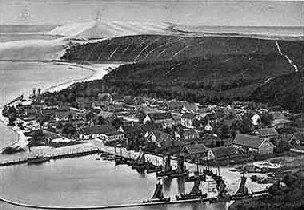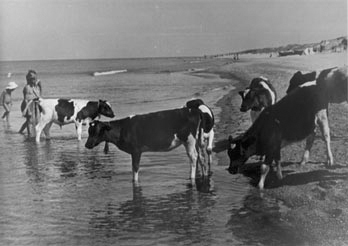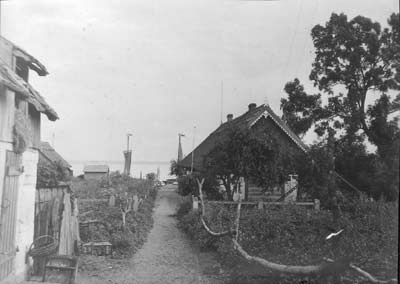Life in Nidden

Nidden - The harbour mole
- Map of the village
- The church in Nidden
- Picture gallery "Old postcards from Nidden"
- Picture gallery "Life
in the village"
The Courland Spit spit has always been a difficult place to life: An almost
hostile environment, more or less consisting of sand without any fertile
ground worth mentioning, requires great stamina to make a living from it.
Sand was everywhere and could be quite dangerous: shifting dunes were threatening
to bury the villages under masses of sand. In the time before the dunes
were paved, eight villages had to be abandoned, the last of them in 1854
has been Negeln.
Nidden as well had to be founded anew in 1740 at its actual spot. Apart
from Rossiten, Nidden has always been the biggest settlement on the s pit
with at last about 800 inhabitants. In the village stood one of the four
churches on the mostly protestant spit, a school, a lighthouse, a youth
hostel and a harbour mole. Until the mole was built of stone in 1904, the
guests had to be shipped from the steamer in small rowing boats on the shore.
pit
with at last about 800 inhabitants. In the village stood one of the four
churches on the mostly protestant spit, a school, a lighthouse, a youth
hostel and a harbour mole. Until the mole was built of stone in 1904, the
guests had to be shipped from the steamer in small rowing boats on the shore.
About one hundred fishing boats may have belonged to Nidden, which were lying in the harbour or on the shore at the properties. As you can see in the village map, the plots were narrow and stretched. Beside the dwelling house, it was important to have a shed, a stable or both harboring the animals, mostly pigs, fowl and other small livestock. Children drove a herd of cattle through the village collecting all cows on their way into the dunes. Small amounts of vegetables were cultivated in the gardens, too.
Fishing and later the summer guests were the most important sources of income. The fisher’s wife mainly attended to the guests staying in the main house, while the family often had to live in the shed during the summer. Organising excursions with the fishing boat and hiring out canoes were tasks of the men and the older boys. Children were supposed to be helping out from an early age. They collected wood, berries or pine cones and took care of the livestock or the garden. Because the spit couldn't produce enough hay for the horses and cows, the families often possessed a property at the other side of the lagoon that was needed to make hay for the winter. They camped for one or two days on the meadow and everybody had to participate in cutting the hay. Then the barge was loaded to the top with hay and sailed very carefully across the lagoon back home.
The entitlement to fish in the lagoon or the Baltic Sea was bound to the
property. There were owners of these rights and so called "Kätner"
from "Kate - small cottage", who were in the pay of the landlords.
The fishing often took place at night and has been - like fishing in all
times - a dangerous affair. Several regulations of what kind of fish was
allowed to catch at what time of the year had to be followed. Provisions
were useful to protect the fishing resource, but they sounded often like
a nuisance to the fishermen. Especially in the Lithuanian time (1923-1939)
trouble with the authorities wasn't anything out of the ordinary. The frontier
to Germany, at the same place as the frontier between Lithuania and the
Russian part of the spit today, has been a region of vibrant and very lucrative
smuggling.

This picture shows how a property at the lagoon is structured seen from the main building: the garden, shed and the barges on the shore.
The photo belongs to the Lauzeningks /Knauerhase family